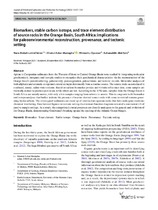Biomarkers, stable carbon isotope, and trace element distribution of source rocks in the Orange Basin, South Africa: implications for paleoenvironmental reconstruction, provenance, and tectonic setting
Date
2021Author
Yelwa, Nura A.
Mustapha, Khairul A.
Opuwari, Mimonitu
Aziz, Azharuddin A.
Metadata
Show full item recordAbstract
Aptian to Campanian sediments from the Western ofshore to Central Orange Basin were studied by integrating molecular
geochemistry, inorganic and isotopic studies to recognize their geochemical characteristics via the reconstruction of the
Orange basin’s paleoweathering, paleosalinity, paleovegetation, paleoclimate, and tectonic records. Molecular analyses of
both aliphatic and aromatic compounds reveal an input dominantly from a marine source. The source rocks accumulated in
a reduced, anoxic, saline water column. Based on various biomarker proxies and vitrinite refectance data, some samples are
thermally mature to produce petroleum, while others are not. According to the V/Ni ratio, samples from the Orange Basin in
South Africa are mainly anoxic, with only a few samples ranging from suboxic to anoxic. This is congruent with biomarker
and isotope analyses that further indicate the presence of marine-derived source rocks with some terrestrial remains gener ating hydrocarbons. The investigated sediments are made up of intermediate igneous rocks that have undergone moderate
chemical weathering. Geochemical fgures on tectonic setting discriminant function diagrams revealed a continental rift of
passive margin settings. As a result, the extrapolated crustal processes are directly analogous to the genesis and evolution of
the Orange Basin, demonstrating Gondwana’s breaking up and the opening of the Atlantic Ocean Margin.

